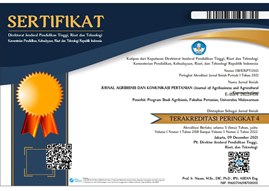Online Submissions
Already have a Username/Password for JURNAL AGRIBISNIS DAN KOMUNIKASI PERTANIAN (Journal of Agribusiness and Agricultural Communication)?
Go to Login
Need a Username/Password?
Go to Registration
Registration and login are required to submit items online and to check the status of current submissions.
Author Guidelines
PANDUAN UNTUK PENULIS (GUIDANCE FOR AUTHORS)
JURNAL AGRIBISNIS DAN KOMUNIKASI PERTANIAN (Journal of Agribusiness and Agricultural Communication)
Jurnal Agribisnis dan Komunikasi Pertanian mempublikasikan hasil-hasil penelitian yang mencakup bidang sosial ekonomi pertanian, ekonomi pertanian, agribisnis, komunikasi pertanian, penyuluhan pertanian, dan bidang lain yang terkait. Manuskrip/naskah yang akan diterbitkan dalam jurnal ini belum pernah diterbitkan dalam media lain. Manuskrip merupakan karya asli dari penulis. Manuskrip ditulis dalam Bahasa Indonesia atau Bahasa Inggris. Manuskrip ditulis di atas kertas kuarto (A4) dengan ukuran kertas 210 mm x 297 mm, naskah terdiri dari 4.000-5.000 kata, Times New Roman 12, diketik 2 spasi, batas margin adalah 3 cm dari tepi atas, tepi bawah, tepi kiri, dan tepi kanan, file dalam bentuk Microsoft Word. Journal of Agribusiness and Agricultural Communication publishes the results of researches with aspects of social agricultural, agricultural economy, agribusiness, agricultural communication, agricultural extension, and others related aspect. Manuscript that will be published in this journal never published elsewhere. Manuscript is original work of author(s). Manuscript is written in Indonesian or English languages. Manuscript is typed on A4 (210 mm x 297 mm), paper size 4,000-5,000 words, Times New Roman 12, double spaces, margins text of 3 cm from the top, bottom, left and right, and word processing program of Microsoft Word. Sistematika penulisan manuskrip sebagai berikut: General format of manuscript are as follows: | |||||||||
1. | Judul. Judul ditulis dalam bahasa Indonesia, tidak lebih dari 15 kata. Title. Title is written in English. | ||||||||
2. | Nama. Nama semua penulis ditulis dengan lengkap. Name. Name of author(s) should be completely written. | ||||||||
3. | Afiliansi. Nama dan alamat instansi dari semua penulis ditulis lengkap dengan nama jalan dan nomor, kode pos, nomor telepon, nomor faksimili, dan alamat email. Affiliation. Name and institution address should be completely written with street name and number (location), postal code, telephone number, facsimile number, and email address. | ||||||||
4. | Abstrak. Abstrak ditulis maksimal 200 kata disertai kata kunci yang diurutkan berdasarkan abjad maksimal 5 kata. Abstrak berisi ringkasan latar belakang penelitian, tujuan, metode penelitian, hasil penelitian, kesimpulan, dan saran. Referensi tidak dikutif dalam abstrak. Singkatan sebaiknya dihindari, tetapi jika penting, maka singkatan harus dijelaskan pada pertama kali dinyatakan. Abstract. An abstract is written maksimum 200 words with keywords are sorted from A to Z. The abstract consists the summary of background, objective, research method, results, conclusions and recommendations. References should not be cited in abstract. Abbreviations should be avoided, but if essential, they must be defined at their first mention. | ||||||||
5. | Pendahuluan. Pendahuluan berisi hal yang melatarbelakangi perlunya penelitian untuk dilakukan, kerangka pemikiran, hasil penemuan dari penelitian sebelumnya, permasalahan yang akan diteliti, tujuan penelitian, dan manfaat penelitian. Kutipan dari pustaka ditulis dengan mencantumkan nama penulis pustaka dan tahun terbit pustaka. Introduction. Introduction consists the background of research, the framework of study, the findings of previous researches, the formulation of problems, the objectives of research, and the benefits of research. The cititation of literatures are written with the name of authors and the published year. | ||||||||
6. | Metode Penelitian. Metode penelitian menjelaskan tentang lokasi dan waktu pelaksanaan penelitian, bahan dan alat yang digunakan, metode pengambilan data, metode pengambilan sampel, metode analisis data atau rancangan statistik yang digunakan. Research Methods. Research method explains about the location and time of researches, materials and tools, method of data collection, method of sampling, method of data analysis or statictical design that used in the research. | ||||||||
7. | Hasil dan Pembahasan. Hasil dan pembahasan disajikan sebagai suatu rangkaian kalimat yang saling berhubungan dan dapat dibagi menjadi beberapa subbab. Hasil disajikan secara rinci, jelas, dan ringkas. Pembahasan disusun untuk menjelaskan hasil penelitian, membandingkan dengan hasil penelitian lain, membahas tentang permasalahan, dan memberikan rekomendasi yang berkaitan dengan temuan penelitian. Tabel dan gambar diberi nomor secara berurutan. Judul tabel ditulis di atas tabel sedangkan judul gambar ditulis di bawah gambar. Results and Discussion. Results and discussion should be written as a series of connecting sentences and it could be divided into subtitles. The results are presented in detail, clear, and compact. The dicussion are arranged to explain the results of research, compare it with other researches, discuss the problems, and offer the recomendations related on the findings of research. Table and figure are given number in accordance with their appearance in the text. Title of a table is written above the table while title of a picture is written down below the picture. | ||||||||
Penulis diwajibkan untuk mengisi formulir penyataan manuskrip. Manuskrip dan formulir pernyataan manuskrip dikirimkan ke http://e-journals.unmul.ac.id/index.php/AKP atau melalui email dengan alamat yaitu jurnal_akp@faperta.unmul.ac.id. Manuskrip akan melalui proses review dan penulis diwajibkan untuk memperbaiki manuskrip sesuai saran dari reviewer. Redaksi berhak menyunting manuskrip tanpa mengubah isi. Manuskrip yang telah diterima akan menjadi artikel dalam jurnal. Jurnal Agribisnis dan Komunikasi Pertanian terbit 6 bulan sekali secara berkala pada bulan April dan Oktober. Author(s) must write a cover letter. Manuscript and cover letter could be sent to http://e-journals.unmul.ac.id/index.php/AKP or through email to jurnal_akp@faperta.unmul.ac.id. Manuscript will be reviewed and author(s) should revise their manuscript as reviewer(s) recommendations. Editor could review manuscript without change the manuscript contents. Manuscript that has accepted will be an article in this journal. Journal of Agribusiness and Agricultural Communication issues every 6 months in April and October. | |||||||||
Submission Preparation Checklist
As part of the submission process, authors are required to check off their submission's compliance with all of the following items, and submissions may be returned to authors that do not adhere to these guidelines.
- The submission has not been previously published, nor is it before another journal for consideration (or an explanation has been provided in Comments to the Editor).
- The submission file is in OpenOffice, Microsoft Word, RTF, or WordPerfect document file format.
- Where available, URLs for the references have been provided.
- The text is single-spaced; uses a 12-point font; employs italics, rather than underlining (except with URL addresses); and all illustrations, figures, and tables are placed within the text at the appropriate points, rather than at the end.
- The text adheres to the stylistic and bibliographic requirements outlined in the Author Guidelines, which is found in About the Journal.
- If submitting to a peer-reviewed section of the journal, the instructions in Ensuring a Blind Review have been followed.
Program Studi Agribisnis, Fakultas Pertanian, Universitas Mulawarman.
Study Program of Agribusiness, Faculty of Agriculture, University of Mulawarman.
Jl. Pasir Balengkong Kampus Gunung Kelua. Kota Samarinda, Provinsi Kalimantan Timur, Indonesia. 75123.
E-mail: jurnal_akp@faperta.unmul.ac.id
_____________________________________________________________________________________________________________________________________________________
![]()

Journal of Agribusiness and Agricultural Communication by http://e-journals.unmul.ac.id/index.php/AKP/ P-ISSN 2622-5050, E-ISSN 2622-6456 is licensed under a Creative Commons Attribution-ShareAlike 4.0 International
https://scientiamilitaria.journals.ac.za/
https://pafidesapancoranmas.org/
https://biograph.jurnal.unej.ac.id/
https://udayannursingcollege.edu.bd/
https://sharifmedicalcity.org/
https://publikacije.uninp.edu.rs/
https://editora-edufatecie.unifatecie.edu.br/
https://astragraphia.org/id/tentang-kami/dewan-komisaris/
https://revistas.itsup.edu.ec/
https://aswajanews.isnuponorogo.org/
slot88matauangslot.online -asli
slot88matauangslot.store -asli
slot777matauangslot.online -asli





.png)
